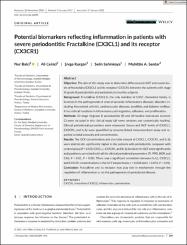| dc.contributor.author | Balcı, Nur | |
| dc.contributor.author | Çekici, Ali | |
| dc.contributor.author | Kurgan, Şivge | |
| dc.contributor.author | Şahinkaya, Selin | |
| dc.contributor.author | Serdar, Muhittin Abdulkadir | |
| dc.date.accessioned | 2021-10-26T12:07:14Z | |
| dc.date.available | 2021-10-26T12:07:14Z | |
| dc.date.issued | 2021 | en_US |
| dc.identifier.citation | Balcı, N., Çekici, A., Kurgan, Ş., Şahinkaya, S. ve Serdar, M. A. (2021). Potential biomarkers reflecting inflammation in patients with severe periodontitis: Fractalkine (CX3CL1) and its receptor (CX3CR1). Journal of Periodontal Research, 56(3), 589-596. https://dx.doi.org/10.1111/jre.12859 | en_US |
| dc.identifier.issn | 0022-3484 | |
| dc.identifier.issn | 1600-0765 | |
| dc.identifier.uri | https://dx.doi.org/10.1111/jre.12859 | |
| dc.identifier.uri | https://hdl.handle.net/20.500.12511/8524 | |
| dc.description.abstract | Objective The aim of this study was to determine differences in GCF and serum levels of fractalkine/CX3CL1 and its receptor/ CX3CR1 between the patients with stage III/grade B periodontitis and periodontally healthy subjects.
Background Fractalkine (CX3CL1), the only member of CX3C chemokine family, is involved in the pathogenesis of several systemic inflammatory diseases' disorders including rheumatoid arthritis, cardiovascular diseases, tonsillitis, and diabetes mellitus. It has critical functions in inflammatory cell migration, adhesion, and proliferation.
Methods 20 stage III/grade B periodontitis (P) and 20 healthy individuals (control; C) were included in this clinical study (all never smokers and systemically healthy). Clinical periodontal parameters were measured. Serum and GCF levels of CX3CL1, CX3CR1, and IL-1 beta were quantified by enzyme-linked immunosorbent assay and reported as total amounts and concentration.
Results The GCF concentrations and also total amount of CX3CL1, CX3CR1, and IL-1 beta were statistically significantly higher in the patients with periodontitis compared with control group (P < 0.05). CX3CL1, CX3CR1, and IL-1 beta levels in the GCF were significantly and positively correlated with all the clinical periodontal parameters (PI, PPD, BOP, and CAL; P < 0.01, P < 0.05). There was a significant correlation between IL-1 beta, CX3CL1, and CX3CR1 concentrations in the GCF (respectively; r = 0.838 and r = 0.874, P < 0.01).
Conclusion Fractalkine and its receptor may play role in mechanisms through the regulation of inflammation or on the pathogenesis of periodontal disease. | en_US |
| dc.language.iso | eng | en_US |
| dc.publisher | Wiley | en_US |
| dc.rights | info:eu-repo/semantics/embargoedAccess | en_US |
| dc.subject | CX3CR1 | en_US |
| dc.subject | Fractalkine (CX3CL1) | en_US |
| dc.subject | Inflammation | en_US |
| dc.subject | Periodontitis | en_US |
| dc.title | Potential biomarkers reflecting inflammation in patients with severe periodontitis: Fractalkine (CX3CL1) and its receptor (CX3CR1) | en_US |
| dc.type | article | en_US |
| dc.relation.ispartof | Journal of Periodontal Research | en_US |
| dc.department | İstanbul Medipol Üniversitesi, Diş Hekimliği Fakültesi, Periodontoloji Ana Bilim Dalı | en_US |
| dc.authorid | 0000-0001-7986-7085 | en_US |
| dc.identifier.volume | 56 | en_US |
| dc.identifier.issue | 3 | en_US |
| dc.identifier.startpage | 589 | en_US |
| dc.identifier.endpage | 596 | en_US |
| dc.relation.publicationcategory | Makale - Uluslararası Hakemli Dergi - Kurum Öğretim Elemanı | en_US |
| dc.identifier.doi | 10.1111/jre.12859 | en_US |
| dc.identifier.wosquality | Q1 | en_US |
| dc.identifier.scopusquality | Q2 | en_US |


















